Photovoltaic carport
T-TYPE CARPORT

The T-type carport is a steel structure similar to the Y-type, focusing on functionality of use and use of available parking space.
It is based on a post fixed to the foundations, which ensures the stability and strength of the entire structure. The modifiable height of the post makes it possible to adjust the height of the carport. The design of the carport is distinguished by two plate girders, which taper towards each other at the far end of the structure to form a T-shape. The use of such shaped profiles not only has a positive effect on the aesthetics, but also allows an ideal balance between strength and weight of the component. The T-type carport is available in two widths: 5 m and 5.7 m. The 5 m version is designed for car parks with a single car space width of 2.5 m, so that the positioning of the post is at the junction of the parking spaces, which has a beneficial effect on the appearance and use of space. The 5.7 m variant, in contrast, with a car space width increased to 2.85 m, offers additional space to make it easier to get out of the vehicles. The arrangement of photovoltaic panels in the T-type carport is a solution best suited to car parks facing south.
 The T-type carport as compared to the Y-type carport has the potential to produce more energy, as it can be favourably positioned to face south. The T-type carport is designed for a front-to-back in-row parking arrangement. It allows optimum use of the available space while ensuring ease of manoeuvring and parking, even for longer vehicles. In addition, the characteristic location of the posts in the central part of the structure makes it significantly easier to open the doors and get out of the vehicles, which is an important aspect in terms of user comfort. The height of the T-type carport at its lowest point can be easily increased or decreased by modifying the post height. This design feature makes it easy to adapt the parking space to different types of vehicles, from cars to trucks. With this solution, the T-type carport represents a versatile parking solution.
The T-type carport as compared to the Y-type carport has the potential to produce more energy, as it can be favourably positioned to face south. The T-type carport is designed for a front-to-back in-row parking arrangement. It allows optimum use of the available space while ensuring ease of manoeuvring and parking, even for longer vehicles. In addition, the characteristic location of the posts in the central part of the structure makes it significantly easier to open the doors and get out of the vehicles, which is an important aspect in terms of user comfort. The height of the T-type carport at its lowest point can be easily increased or decreased by modifying the post height. This design feature makes it easy to adapt the parking space to different types of vehicles, from cars to trucks. With this solution, the T-type carport represents a versatile parking solution.
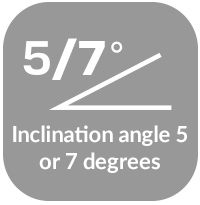

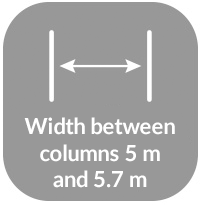

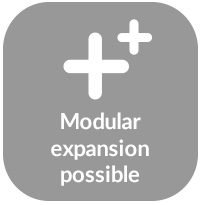
TECHNICAL DATA
| Number of spaces / 1 carport | 4 |
| Number of PV modules / 1 carport | 30 ÷ 36 [pcs] |
| PV module dimensions | any |
| Power / 1 carport | 13 ÷ 21,6 [kWp] |
| PV module brand | any |
| Material | S355JR + S235 |
| Protective coating | Hot-dip galvanised |
| Structural strength | Snow zone 3 |
| Coating warranty | 15 years |
| Structural warranty | 15 years |
| Extendable | Yes |
| Assembly system | Proprietary Tiga-Cynk |
| Technical and construction documentation | Included |
| Assembly instructions | Included |
| Foundation anchor cage | Available for purchase in the set |
| Installation of inverter and car charger possible | Yes |
| Painting | Optional |
| Sealed roof | Optional |
| Construction of concrete/screw foundations | Optional by subcontractor |
DIMENSIONS
| Min. height | 2,6 ÷ 4,6 [m] |
| Max. height | 4,2÷ 6,2 [m] |
| Width at centreline | 5 ÷ 5,7 [m] |
| Depth | 12,3 [m] |
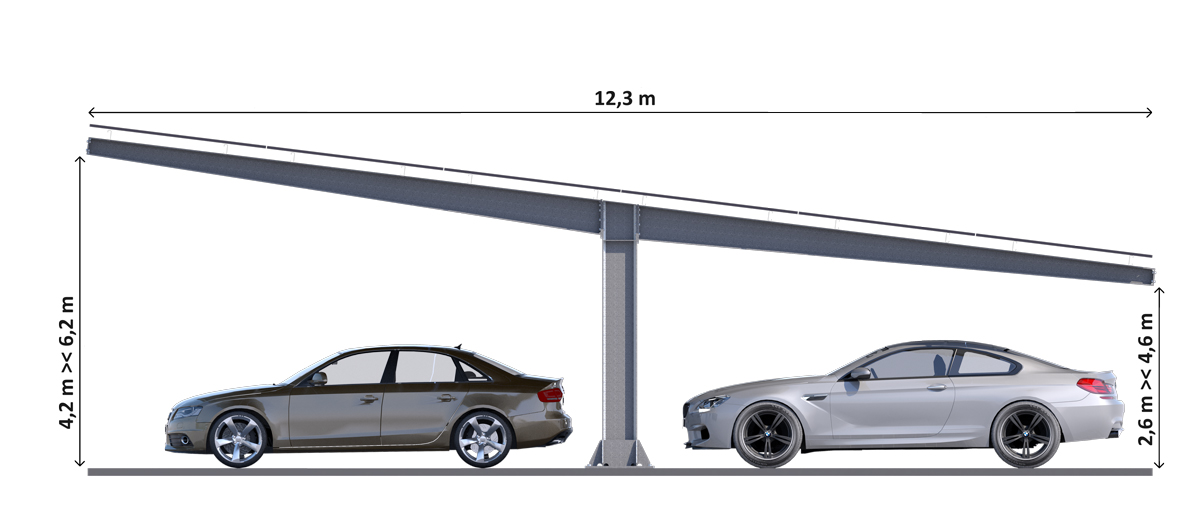
STANDARDS
| PN-EN 1090 Execution of steel structures |
| PN-EN 1991 Actions on structures |
| PN-EN 1993 Design of steel structures |
| PN-EN 1461 Hot dip galvanizing on iron and steel products |
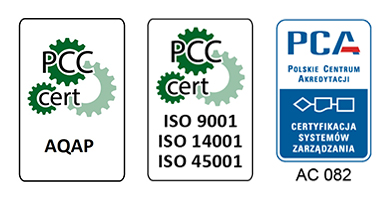
 The roof of the carport is formed by photovoltaic panels, which play a dual role - primarily they are used to produce electricity from RES. Carport areas are perfect for producing green energy and increasing energy efficiency - large areas exposed to the sun can generate energy, the potential consumers of which are the facilities (shops, businesses) that are most often located in close proximity to them.
The roof of the carport is formed by photovoltaic panels, which play a dual role - primarily they are used to produce electricity from RES. Carport areas are perfect for producing green energy and increasing energy efficiency - large areas exposed to the sun can generate energy, the potential consumers of which are the facilities (shops, businesses) that are most often located in close proximity to them.
The structures we offer allow photovoltaic panels to be installed on the surfaces of car parks that already exist, e.g. in city centres, which is an alternative considering the high price of land. The second key role of the carport is to protect vehicles from the sun and precipitation (hail, snow, rain).
 The use of a carport equipped with photovoltaic panels brings significant economic benefits by reducing electricity costs. With the production of their own green energy, users can significantly reduce their electricity bills, while increasing energy independence. In addition, photovoltaic carports make a practical contribution to the idea of sustainable development by offering a solution that not only supports environmental protection by reducing carbon emissions, but also promotes the use of renewable energy sources.
The use of a carport equipped with photovoltaic panels brings significant economic benefits by reducing electricity costs. With the production of their own green energy, users can significantly reduce their electricity bills, while increasing energy independence. In addition, photovoltaic carports make a practical contribution to the idea of sustainable development by offering a solution that not only supports environmental protection by reducing carbon emissions, but also promotes the use of renewable energy sources.
 The presence of carports in both public and private car parks underlines the sustainability of modern parking solutions, while demonstrating that environmentally friendly technologies can be effectively integrated into everyday life.
The presence of carports in both public and private car parks underlines the sustainability of modern parking solutions, while demonstrating that environmentally friendly technologies can be effectively integrated into everyday life.

